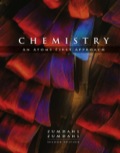
Concept explainers
Anthraquinone contains only carbon, hydrogen, and oxygen. When 4.80 mg anthraquinone is burned, 14.2 mg CO2 and 1.65 mg H2O are produced. The freezing point of camphor is lowered by 22.3°C when 1.32 g anthraquinone is dissolved in 11.4 g camphor. Determine the empirical and molecular formulas of anthraquinone.
Interpretation: The empirical formula and molecular formula of Anthraquinone has to be determined.
Concept Introduction:
The ratio of the elements present in a compound and not the arrangement of the atoms are called as Empirical formula
Molecular formula is the representation of sum of number of atoms and molecules, not their arrangement in structure.
Answer to Problem 132IP
The empirical formula of Anthraquinone is
The molecular formula of Anthraquinone is
Explanation of Solution
Record the data
Mass of Carbon dioxide =
Mass of Water =
Freezing point of Camphor =
Mass of Anthraquinone burned =
Mass of Anthraquinone Dissolved =
Mass of Camphor =
To calculate the mass percent of Carbon, Hydrogen and Oxygen
Atomic mass of Carbon =
Molar mass of Carbon dioxide =
Atomic mass of Hydrogen =
Molar mass of Water =
Mass of Carbon =
Mass percentage of Carbon =
=
Mass of Hydrogen =
Mass percentage of Hydrogen =
=
Mass percentage of Oxygen =
=
Mass percentage of Carbon =
Mass percentage of Water =
Mass percentage of Oxygen =
To calculate the empirical formula
Mass percentage of Carbon =
Mass percentage of Hydrogen =
Mass percentage of Oxygen =
Out of
Therefore, the empirical formula is
Record the given info
Freezing point of Camphor =
Molal freezing point depression constant =
Mass of Anthraquinone burned =
Mass of Anthraquinone Dissolved =
Mass of Camphor =
To calculate the mass of Anthraquinone (m),
Molal of Anthraquinone =
Moles of Anthraquinone =
=
Moles of Anthraquinone =
To calculate the molar mass
Moles of Anthraquinone =
Mass of Anthraquinone Dissolved =
Molar mass of Anthraquinone =
=
To determine the Molecular formula of Anthraquinone
Empirical formula mass =
Molar mass of Anthraquinone =
Molar mass of Anthraquinone is twice the empirical mass of Anthraquinone, therefore the molecular mass of Anthraquinone is
Molecular Mass of Anthraquinone =
The moles of individual elements were calculated by using the mass percentages to their molar masses. The moles of the individual elements were divided by smallest ratio of moles and approximated to determine the empirical formula. The empirical formula was found to be
The molecular mass of Anthraquinone is calculated by using the molar mass and empirical formula mass. The molecular mass of Anthraquinone was
Want to see more full solutions like this?
- For each of the following pairs of solutions, select the solution for which solute solubility is greatest. a. Ammonia gas in water with P = 1 atm and T = 50C Ammonia gas in water with P = 1 atm and T = 90C b. Carbon dioxide gas in water with P = 2 atm and T = 50C Carbon dioxide gas in water with P = 1 atm and T = 50C c. Table salt in water with P = 1 atm and T = 60C Table salt in water with P = 1 atm and T = 50C d. Table sugar in water with P = 2 atm and T = 40C Table sugar in water with P = 1 atm and T = 70Carrow_forwardStarch contains CC, CH, CO, and OH bonds. Hydrocarbons have only CC and CH bonds. Both starch and hydrocarbons can form colloidal dispersions in water. Which dispersion is classified as hydrophobic? Which is hydrophilic? Explain briefly.arrow_forwardAn unknown compound contains only carbon, hydrogen, and oxygen. Combustion analysis of the compound gives mass percents of 31.57% C and 5.30% H. The molar mass is determined by measuring the freezing-point depression of an aqueous solution. A freezing point of 5.20C is recorded for a solution made by dissolving 10.56 g of the compound in 25.0 g water. Determine the empirical formula, molar mass, and molecular formula of the compound. Assume that the compound is a nonelectrolyte.arrow_forward
- A compound has a solubility in water of 750 mg/L at 25C. Should this compound be characterized as a soluble or insoluble compound at 25C?arrow_forwardFor each of the following pairs of solutions, select the solution for which solute solubility is greatest. a. Oxygen gas in water with P = 1 atm and T = 10C Oxygen gas in water with P = 1 atm and T = 20C b. Nitrogen gas in water with P = 2 atm and T = 50C Nitrogen gas in water with P = 1 atm and T = 70C c. Table salt in water with P = 1 atm and T = 40C Table salt in water with P = 1 atm and T = 70C d. Table sugar in water with P = 3 atm and T = 30C Table sugar in water with P = 1 atm and T = 80Carrow_forwardConcentrated hydrochloric acid contains 1.00 mol HCl dissolved in 3.31 mol H2O. What is the mole fraction of HCl in concentrated hydrochloric acid? What is the molal concentration of HCl?arrow_forward
 ChemistryChemistryISBN:9781305957404Author:Steven S. Zumdahl, Susan A. Zumdahl, Donald J. DeCostePublisher:Cengage Learning
ChemistryChemistryISBN:9781305957404Author:Steven S. Zumdahl, Susan A. Zumdahl, Donald J. DeCostePublisher:Cengage Learning Chemistry: An Atoms First ApproachChemistryISBN:9781305079243Author:Steven S. Zumdahl, Susan A. ZumdahlPublisher:Cengage Learning
Chemistry: An Atoms First ApproachChemistryISBN:9781305079243Author:Steven S. Zumdahl, Susan A. ZumdahlPublisher:Cengage Learning
 Chemistry: Principles and PracticeChemistryISBN:9780534420123Author:Daniel L. Reger, Scott R. Goode, David W. Ball, Edward MercerPublisher:Cengage Learning
Chemistry: Principles and PracticeChemistryISBN:9780534420123Author:Daniel L. Reger, Scott R. Goode, David W. Ball, Edward MercerPublisher:Cengage Learning Chemistry & Chemical ReactivityChemistryISBN:9781133949640Author:John C. Kotz, Paul M. Treichel, John Townsend, David TreichelPublisher:Cengage Learning
Chemistry & Chemical ReactivityChemistryISBN:9781133949640Author:John C. Kotz, Paul M. Treichel, John Townsend, David TreichelPublisher:Cengage Learning Chemistry: The Molecular ScienceChemistryISBN:9781285199047Author:John W. Moore, Conrad L. StanitskiPublisher:Cengage Learning
Chemistry: The Molecular ScienceChemistryISBN:9781285199047Author:John W. Moore, Conrad L. StanitskiPublisher:Cengage Learning





